5 Fresh Openings to Try Now in Athens
Discover five of Athens’ latest openings,...
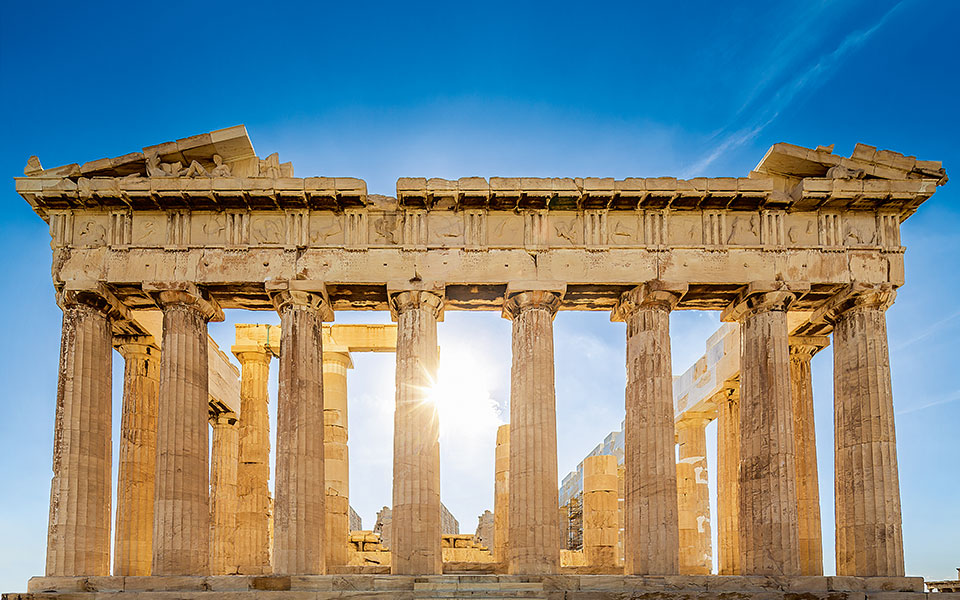
The eastern facade of the time-ravaged, forever elegant lady of the Acropolis – the Parthenon.
© Getty Images/Ideal Image
It is impossible not to be awed when one stands in the shadow of the great Parthenon and looks up at its elegantly carved Doric columns towering overhead. The quality of the craftsmanship, the stunning white Pentelic marble, the sheer size of this 2,500-year-old temple dedicated to Athena Parthenos – the virgin goddess and patron deity of ancient Athens – are all features of a unique, world-class monument that strike us immediately. However, there is much more to the Parthenon than first meets the eye.
As viewers, we welcome and accept the temple’s outward beauty and seeming perfection, but we don’t often stop to ask ourselves why the building so affects us. The answer is that the Parthenon’s architects, Ictinus and Callicrates, and its chief sculptural artist, Phidias, have incorporated numerous “hidden” devices within its marble construction and carved decorations that were designed to trick the viewers’ eye, to make us believe we are witnessing something perfectly regular, sensible and balanced in all its aspects.
These almost imperceptible optical refinements and other little adjustments or design tricks allow us to unwittingly take in the details of the Parthenon more easily, to appreciate them more fully and to not be disturbed by unpleasant optical illusions that otherwise could have been caused by the building’s massive scale and the basic nature of ancient post-and-lintel architecture.
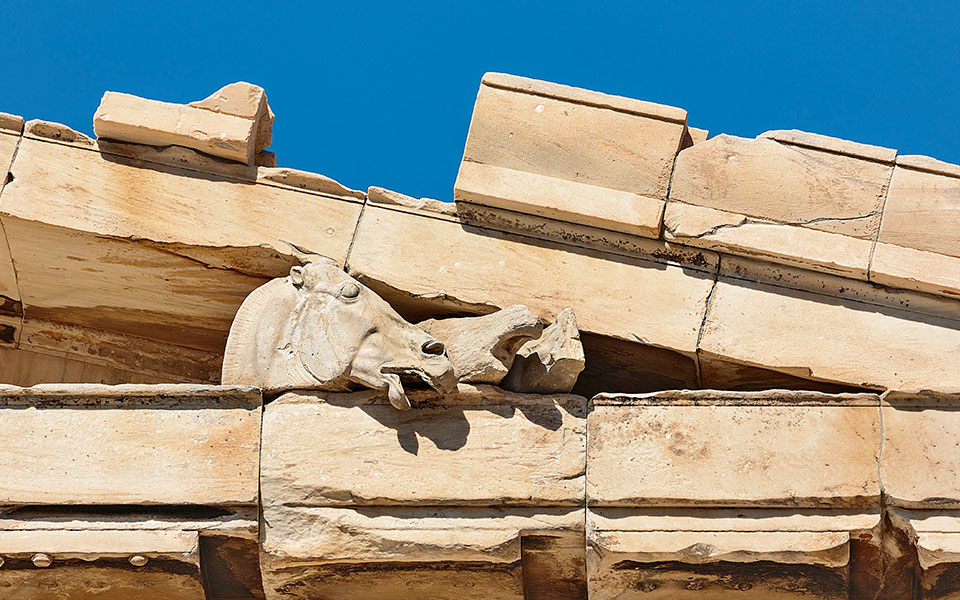
The Parthenon’s eastern pediment tells the story of the birth of Athena, framed by the rising and sinking chariots of Helios (Sun) and Selene (Moon) – a special day in the life of the world.
© Getty Images/Ideal Image
Looks certainly can be deceiving! Who would believe that, in fact, there are virtually no straight lines or right angles in the Parthenon? This enormous temple appears at first glance to be a giant rectilinear construction, all of whose lines are straight! And does it seem sensible to the rational mind that the base of the temple – its stepped pedestal or stylobate – is actually domed, not flat?
The four corners of the pedestal droop gracefully downward, such that if one were to stand on the top step and look lengthwise along the building at someone else also standing on the same step at the opposite end, these two observers would only see each other from about the knees up. This doming of the temple base was reputedly done to avoid an optical “sagging” of the building’s middle that would have been perceived along its east and west ends and especially along its long north and south sides, if its lines were actually designed and built to be perfectly straight.
Additional refinements in the Parthenon include the slight inward leaning of all the columns in the Doric colonnade surrounding the building. The corner columns are slightly larger in diameter than the others and lean inward in two directions; that is, diagonally to the corner. They also are set in such a way that there exists a smaller space, or intercolumniation, between them and the next column.
Meanwhile, the columns themselves are not straight along their vertical axes, but swell in their middles. This phenomenon, called “entasis,” intended to counteract another optical effect in which columns with straight sides appear to the eye to be slenderer in their middles and to have a waist. Furthermore, the whole superstructure of the outer facades of the temple, above the level of the columns (the “entablature”), also curves downward at the corners, to mirror the stylobate and carry upward the temple’s overall domed curvature.
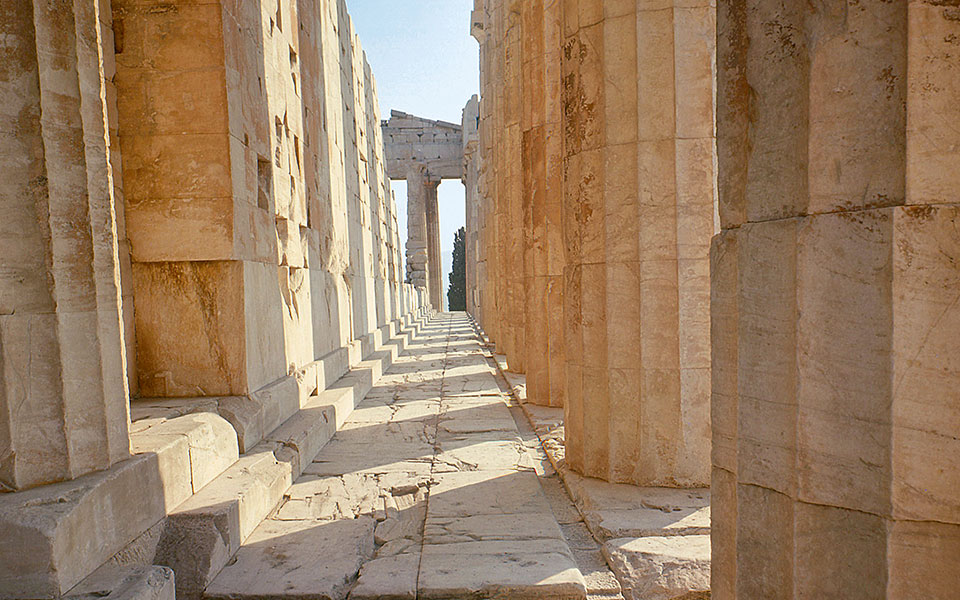
The southern walkway (pteron) of the Parthenon, whose domed curvature pleased the eye and shed rainwater.
© Getty Images/Ideal Image
Different theories have been advanced as to why the Parthenon, and other earlier Greek temples, include all these optical devices. The first, already mentioned, which suggests that the architects were providing “counter-perspective” in order to reduce or eliminate unpleasant optical phenomena inherent to post-and-lintel architecture with its long horizontal and vertical lines, was first proposed by the Roman architect Vitruvius in the 1st c. BC. Since then, observers and specialists have also suggested that Ictinus and Callicrates may have wanted to animate the building, to breathe a more natural life into it – as truly straight lines are actually quite rare in nature and curves make the structure seem more alive.
However, the Parthenon’s curves are hidden, almost invisible to the naked eye and what the designers of ancient Greek temples were ultimately striving to achieve was, more likely, true perfection; a quality of perfection worthy of the gods. This religious and artistic quest is also seen in the pedimental sculpture of the Parthenon, where the statues were finished completely, not only on their front sides that were clearly visible to viewers, as in later Roman temples.
The outer façades’ metope panels were more deeply cut in their lower portions and almost seem to lean outward and downward slightly to better face the reverent and curious below.
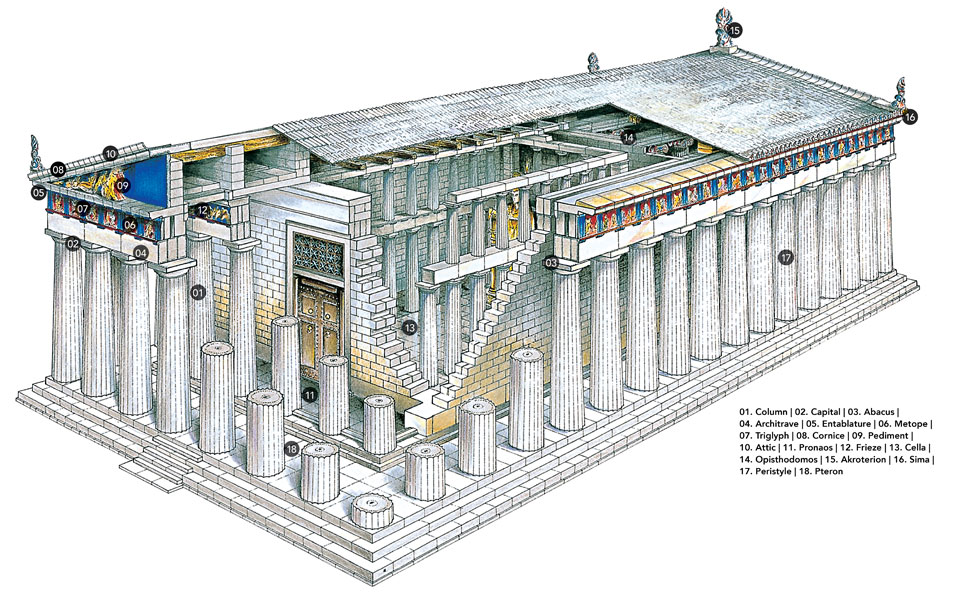
The anatomy of a "living" temple
The optical adjustments made to the Parthenon were not unique, but represented the culmination of many generations of architects’ efforts to establish a standard code or “canon” traditionally required for the design of Greek temples. The narrowing of the corner intercolumniation was done to follow the “rule” that in Doric-style architecture the triglyphs in the entablature had to be arranged with one triglyph centered over each column. Such details of arrangement were references to previous, longstanding, slow-to-change practices in religious architecture.
Similarly, individual features of the Parthenon’s façade – including the triglyphs, and the mutules and guttae below them – were visual reminders of particular elements of past temples’ original wooden construction. The mutules may have signified the protruding ends of roof beams; the guttae, wooden pegs used to secure these beams; and the triglyphs, the covers that originally capped the beam ends.
Visual “corrections” were already known in many other temples throughout the Greek world. A domed stylobate, for example, existed in the Archaic or early Classical temples of Apollo at Corinth and Athena (pre-Parthenon) in Athens. The columns of temples in Aegina, Tegea and Nemea were already leaning inward to some degree in the 6th c. BC, while the swelling of columns was evident at sanctuaries including Olympia and, most noticeably, Paestum in Magna Graecia (southern Italy).
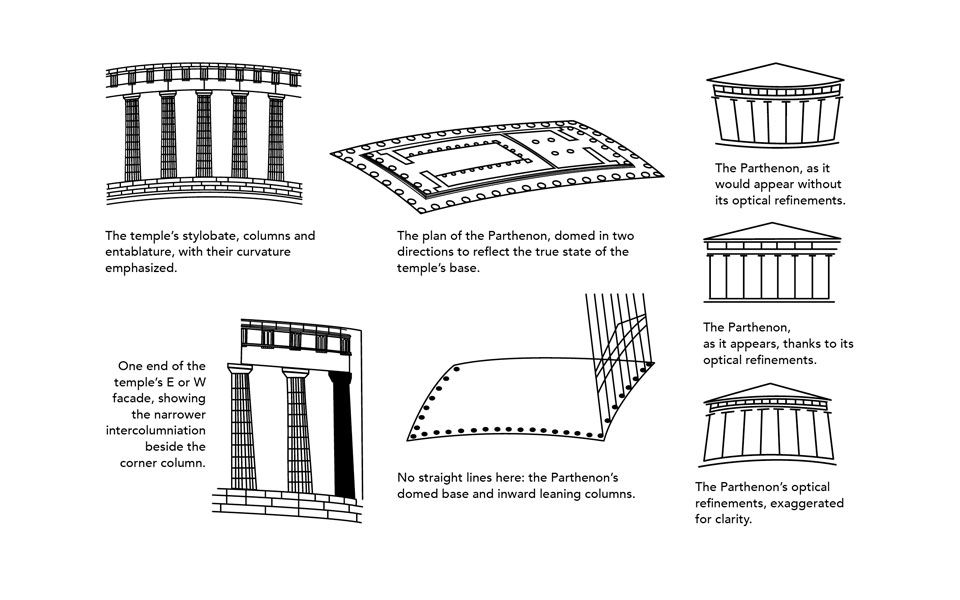
In the Parthenon however, architects and artists combined forces to produce the most refined and perfect example of a Greek temple known to date.
Because the Parthenon had few straight lines and right angles, its designers and builders had to hand-craft each individual piece, among a total of over 70,000 architectural members, so as to fit them into their own specific place within the temple’s structure. Differences amounting to as little as a few millimeters often distinguish these members.
As a result, today’s restorers have had their work literally cut out for them in order to find the original positions of all the Parthenon’s surviving blocks. This extraordinary modern effort, not undertaken by previous restorers including Nikolaos Balanos in the 1920s, has led to the Parthenon – one of antiquity’s most painstakingly and precisely constructed buildings – once again becoming about as “perfect” as its ancient human creators and present-day caretakers could make it.
The Acropolis
Tel. (+30) 210.321.4172
Open daily 8:00-16:30 (November-March)
Admission έ10 (There is also a έ30 ticket allowing admission to all main archaeological sites in Athens)
Discover five of Athens’ latest openings,...
Lost to earthquakes, swallowed by the...
Xenokratous Street in Kolonaki is one...
Antiques expert and collector Dimitris Xanthoulis...